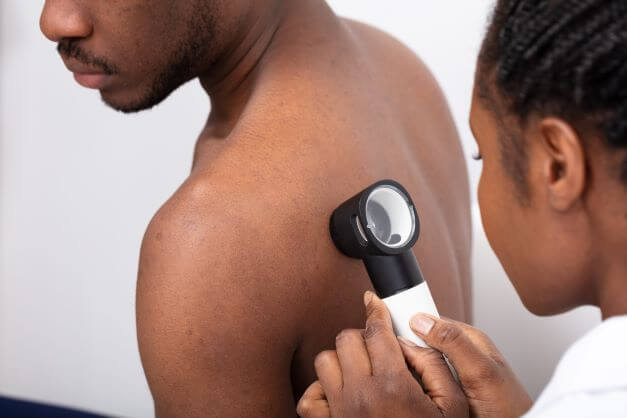Historically, African Americans have what can euphemistically be referred to as a challenging history with medical care providers of all kinds. At best, people of color have received generic treatments that weren’t developed with their specific needs in mind, but at worst, abuse, neglect, and trauma occurred. There is a long way to go to correct the damage of this sordid past and fill in deficits in available care for people of color. Many medical fields are making big strides in being more inclusive, and that includes dermatology. While there are still many dermatologic products and treatments that won’t work for African Americans, there is current research underway to improve existing products and treatments and develop new ones with skin of color in mind. On this page, you can learn more about the benefits of visiting an African American Dermatologist and some of the available products that will keep your skin looking great.
Why It’s Important to See a Dermatologist Who Gets It
Most skincare products and treatments are developed and formulated to work well with lighter-colored skin. It’s an unfortunate form of invisible privilege that benefits light-skinned people and leaves African Americans with fewer options. For this reason, it’s essential to work with a dermatologist who understands three key elements of caring for African American skin:
- Certain products and dermatologic treatments won’t work well or at all for people of color.
- Many skin conditions impact skin of color differently than lighter skin.
- African Americans and others with darker skin tones need a unique treatment approach that considers these differences in order to help them achieve and maintain healthier skin.
If you find a dermatologist who understands these three things, you are significantly more likely to have healthier skin and feel more confident. More importantly, receiving treatment from a dermatologist who understands your needs and helps you achieve your skin health goals is something people with lighter tones are able to take for granted, and people of color deserve this same level of care and support. Do yourself the favor of working with a dermatologist who gets it.
Common Concerns for Skin of Color
Perhaps the most important reason to visit a Black dermatologist is simple – they understand the common skin health concerns because they’ve been there. This means they are able to more quickly diagnose issues that arise and help you find the best treatment option. Below, we’ve outlined some of the most common skin conditions faced by people of color and the treatments that may be recommended to address them.
Keloids
Scarring is the skin’s natural response to traumatic injuries like cuts, scrapes, and burns as well as procedures like surgery, ear piercing, and tattooing. Unfortunately, some forms of scarring cause excessive tissue growth. Keloids are the most common form of irregular scarring. They cause smooth growths that look like lumps or bumps protruding from the skin. Usually, keloids develop around an injury site, but they can develop without any specific cause. They are not harmful or dangerous, but they can be a cosmetic concern. For some people, keloids can also itch or feel uncomfortable. While anyone can develop keloids, they are significantly more common for people of color, especially around the ears. Because injuries cause keloid development, it’s no surprise that a special approach is required to remove this irregular scar tissue without causing additional keloid production. There are specific surgical techniques that minimize the risk of scar tissue development during surgical excision. Treatment may also involve using injected corticosteroids to minimize the size of keloids.
Hyperpigmentation
There are many different types of hyperpigmentation, which is an umbrella term for skin darkening due to excessive pigment production. While anyone can experience hyperpigmentation, people of color are more likely to develop a few forms of hyperpigmentation, including melasma, post-inflammatory hyperpigmentation, Dermatosis Papulose Nigra (DPN), and exogenous ochronosis. Melasma causes dark brown patches to develop on the face and other areas that receive excessive sun exposure. Most frequently, these melasma patches develop on the forehead, cheeks, and mouth. Melasma often occurs due to hormonal changes, including shifts that occur when taking hormonal birth control pills. Post-inflammatory hyperpigmentation occurs in areas where the skin is injured, and it’s most often connected to acne scars. DPN is a condition that can affect all people with darker skin tones, but it’s much more common for African Americans. It causes small papules to develop. They are usually small and black or dark brown. Exogenous ochronosis is a form of skin discoloration that typically affects the skin around the face or eyes. It’s almost always caused by the long-term use of hydroquinone, a skin-lightening product.
Treatment options for hyperpigmentation include topical creams and chemical peels. For melasma, changing to non-hormonal birth control, limiting sun exposure, and choosing a strong sunscreen can also help to prevent melasma from developing and aid in lightening existing patches. For DPN, laser removal or cryotherapy may be beneficial. Treatment for exogenous ochronosis usually involves foregoing the use of any products that may have caused the condition in combination with some of the other procedures we’ve recommended.
Vitiligo
Vitiligo is a condition that causes parts of the skin to become lighter. While this condition also impacts people with lighter skin tones, it’s much more noticeable and more common for those with darker skin. Vitiligo is caused by an autoimmune disorder that makes the body attack and destroy pigment-producing skin cells. As a result, skin is much lighter in the affected areas. For some, this condition is generalized, meaning it occurs all over the body. In other cases, it’s localized, meaning it’s concentrated in a specific area. It’s very difficult to treat vitiligo. In most cases, dermatologists work with patients to prevent further loss of pigmentation, using medications like calcineurin inhibitors or corticosteroids. Laser or light therapy may also be recommended.
Skin Cancer
The deadliest form of skin cancer, melanoma, is, luckily, also the rarest. While people of color aren’t more likely to develop melanoma, they may be more likely to die from melanoma due to being diagnosed in the later stages of the condition. The reason for this is African Americans tend to develop melanoma skin cancer in harder-to-see places like nail beds, between toes and fingers, on the soles of feet, in the mouth, or on the genitals. This form of melanoma, called acral lentiginous melanoma, also tends to be significantly more aggressive, and it doesn’t appear to be caused by sun exposure like other forms of melanoma. Because of this, it’s essential to perform regular skin cancer self-checks and take special care to examine these harder-to-see places where acral lentiginous melanoma often develops. As soon as you notice any skin changes that may be indicative of melanoma skin cancer, you should contact your dermatologist.
Acne
Acne is an extremely common skin condition that often appears for the first time during puberty. While African Americans aren’t necessarily more likely to have acne, they are more likely to experience severe forms like cystic acne. Additionally, they often have more severe side effects after acne breakouts, including scarring and dark spots. Acne treatment products may cause adverse effects on skin of color, including dryness, inflammation, and hyperpigmentation. Treating acne will depend on the severity of the acne, and your dermatologist can help you develop a plan to address and prevent breakouts. That all starts with selecting gentle but effective skincare products for acne that will minimize the risk of side effects. It’s always best to partner with a dermatologist to develop a personalized treatment plan, but the EltaMD Acne-Prone Skin Kit is a great option to get started preventing breakouts without irritating skin.
Find an African American Dermatologist
If you’re interested in seeing a Dermatologist who understands the special needs of skin of color, U.S. Dermatology Partners is here for you. Whether you need help with a chronic skin condition, you want to learn more about effective skincare, or it’s time for your annual skin exam, the featured physicians below have the expertise you need. This list below includes African American Dermatologists and other U.S. Dermatology Partners physicians who have specialized experience in the care of darker skin tones. Then, don’t hesitate to get in touch with the team at U.S. Dermatology Partners. We offer a simple online scheduling request form to make the process quick and easy. Once you submit your request, a team member will be in touch shortly to discuss the details of your visit.
Find a location near me
or























